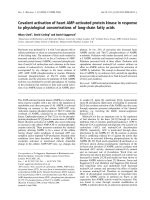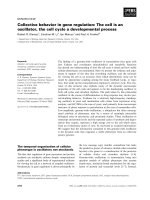EY Understanding customer behavior in retail banking - The impact of the credit across Europe docx
Bạn đang xem bản rút gọn của tài liệu. Xem và tải ngay bản đầy đủ của tài liệu tại đây (859.05 KB, 32 trang )
Understanding customer
behavior in retail banking
The impact of the credit crisis across Europe
February 2010
Contents
Introduction . . . . . . . . . . . . . . . . . . . . . . . . . . . . . . . . . . . . . . . . . . 1
Executive summary
. . . . . . . . . . . . . . . . . . . . . . . . . . . . . . . . . . . . 2
. . . . . . . . . . . . . . . . . . . . . . . . . . . . . . . . . . . . . . . . . . 5
The impact on trust
. . . . . . . . . . . . . . . . . . . . . . . . . . . . . . . . . . . . 6
Loyalty: the end of an era?
. . . . . . . . . . . . . . . . . . . . . . . . . . . . . . 8
Reasons customers look elsewhere
. . . . . . . . . . . . . . . . . . . . . . 14
Measuring satisfaction
. . . . . . . . . . . . . . . . . . . . . . . . . . . . . . . . . 18
Conclusion
. . . . . . . . . . . . . . . . . . . . . . . . . . . . . . . . . . . . . . . . . . 24
How Ernst & Young can help
. . . . . . . . . . . . . . . . . . . . . . . . . . . . 26
Contacts
. . . . . . . . . . . . . . . . . . . . . . . . . . . . . . . . . . . . . . . . . . . . 28
1
Understanding customer behavior in retail banking The impact of the credit crisis across Europe
In the last two years, the European banking market has witnessed unprecedented turmoil as it has
It costs retail banks as much as six times more to attract a new customer as it does to retain an
existing one, and yet for many years the industry has not always focused on customer loyalty and
fostering loyal customers is important to achieve growth.
In the research that follows, Ernst & Young surveyed bank customers (individual consumers)
across six European countries – in Belgium, France, Germany, Italy, Spain and the UK. More than
their levels of satisfaction, what they were looking for from the institutions, and their intentions
and demands going forward.
We conducted this research with the objectives of:
Highlighting the risks and opportunities facing the retail banking sector with respect to
managing customer relationships today across Europe.
Analyzing what is relevant to a successful banking relationship, so as to achieve and maintain
customer satisfaction in the current climate.
Identifying and commenting on what we see as the key action points that banks must take if
they are to continue expanding their customer base in a challenging market.
We would like to thank the participants for their valuable time and insights, and we hope that
global credit crisis.
Beatriz Sanz Saiz
Global Customer Leader
Performance Improvement
Pierre Pilorge
EMEIA Financial Services Advisory
Markets Leader
Introduction
2
Understanding customer behavior in retail banking The impact of the credit crisis across Europe
Without doubt, the credit crisis has had a profound and lasting effect on the way in which
institutions were among the most respected and trusted organizations on the high street; today,
customer trust in banks has fallen dramatically. Across Europe, some 45% of customers say the
crisis has had a negative, or very negative, impact on their trust in the banking industry.
With diminishing trust comes diminishing loyalty and our survey uncovers a marked and
main bank with which customers hold most of their accounts and do the majority of their
business is blurring across Europe.
Our survey found that 24% of respondents had at some point changed their bank account, with
10% of the change happening in the last two years alone. A further 11% of Europeans say that they
plan to change their main provider in the future. Customers in Spain (20%) and Italy (14%) are the
most likely to change their banks with only 6% in Belgium and France planning to do likewise.
Risks and opportunities
demanding. Consumer perceptions are changing at a rapid rate, and banks face both a threat of
customers accessing some, if not all, of their services from other providers, while similarly an
opportunity to gain market share.
allegiances across a number of providers. Almost a quarter of European customers now hold
more than two accounts with a second bank, and one in ten source more than two services from
a third provider. However, the fact that three quarters of customers who use more than one bank
have only one product with each of their other banks, suggests that customers are more likely
multipurpose bank to customer demand for new specialist banks?
Customers are requesting specialized products and high service quality, and these requirements
between increasing specialization of products and service and the continuous drive towards
models in light of these issues.
Executive summary
3
Understanding customer behavior in retail banking The impact of the credit crisis across Europe
We also found differences across the markets: customers in Spain (44%) and France (40%) are
average across the six countries. UK customers (27%) are most likely to have just one product
with their main bank compared to 19% across Europe.
develop a better relationship based on current purchasing habits, and then maintain and adapt
customers that should be targeted most proactively as promoters of the bank to new customers.
Services can be tailored differently to these customers using sophisticated customer analysis, while
‘’Introduce a friend’’ schemes and loyalty programs help to value their commitment to the bank.
Building successful relationships
Customer satisfaction has never been such a major concern for European banking leaders.
customers. In our survey, the expected drivers of satisfaction; price, service and the product
offering, are the three main causes of customer dissatisfaction. In light of the credit crisis, 25%
of respondents who plan to leave their bank cited lack of trust as the reason to change.
The reasons for moving banks were different across the markets. Price was a key factor for
Italian (50%) and German (55%) customers but not for French and UK customers, where only
giving this as the main reason for changing banks.
loyal customers. As service channels move towards online banking and telephone banking,
customers still demand personal relationships with their banks. A third of our respondents,
rate personal relationships as highly important and 46% considered the current level of
personal service to be either bad or limited. This again varies across the markets with the
describing the level of personal attention as excellent.
While capitalizing on the cost reduction opportunities offered by new channels, banks must be
mindful of a return to traditional values brought about by the credit crisis, as customers once
also need to ensure that the new channels meet the customer needs. We found that among the
uninterested in mobile telephone banking.
4
Understanding customer behavior in retail banking The impact of the credit crisis across Europe
Knowing your market
As well as segmenting the customer behaviors within each institution, it is clear from our
jurisdiction has been impacted differently by the credit crisis. In particular, UK customers report
a heightened loss of trust compared with those in other countries. There, 56% of customers say
that their trust in banks has been negatively impacted, showing the clear need for work to be
done by the institutions active in that market.
Banks need to consider ways in which they might enhance trust among their customer base,
perhaps by better communicating messages around ethical practices and changes in behavior.
when developing new products and new ways of providing customer service. The impact of the
them in tailored ways across different markets.
The regulatory backdrop
banks interact with their customers. For example, by now, all banks operating in the UK should
have embedded the Financial Services Authority’s principles of “Treating Customers Fairly” into
banks to revisit policies on clear and accurate communications in the sales process to ensure the
accompanying cultural changes have been incorporated into the business.
Banks should also be mindful of the new dispute regulations concerning customer complaints
procedures, and the new Common Principles for Bank Account Switching, which will further
impact customer relationships, and are covered later in this report.
Summary
Banks must now take a good look at their customer base, examine what customers want, which
differentiate themselves from the competition.
5
Understanding customer behavior in retail banking The impact of the credit crisis across Europe
Key findings
Customers are looking to move provider or diversify their banking portfolio, spreading
perceived risks.
sections of the report.
The impact on trust
Today’s economic recession has had a negative impact on the trust that 45% of
Europeans have in their banking providers.
The UK has been most negatively impacted with 56% saying their trust in banks
has decreased.
In contrast, 60% of German respondents say the crisis has made no difference to their
level of trust.
Loyalty
Among customers who have more than one bank, 74% have only one product with
More than half (54%) agree they would join a loyalty program if their bank offered one.
French and Belgium customers hold the longest relationships with their banks with
Reasons customers look elsewhere
24% of respondents have changed their main banking provider at some point in their
life, but 10% did it in the last two years.
A further 11% plan to change imminently which points to a recent acceleration.
customers to change their banks.
Measuring satisfaction
Service quality is the most important criteria for customers when choosing a bank.
Nearly a third of customers consider a personal relationship with their bank advisor to
be highly important when choosing a bank.
say the attention they receive is bad. Whereas 40% of Spanish respondents describe
the personal attention from their bank as excellent.
6
Understanding customer behavior in retail banking The impact of the credit crisis across Europe
The impact on trust
banking sector globally, causing bank failures and even systemic meltdowns in certain European
jurisdictions, those relationships have never been more dependent on a level of trust.
Perhaps the most profound effect of the credit crisis on the banking industry is a dramatic fall
in the amount of trust it enjoys among its customers. Across Europe, 45% of respondents said
perhaps compounded by the media attention that has been given to banking losses and collapses
the world over. Further damage has been done to the industry by the global furore that has
surrounded the payment of bonuses within banks that have sometimes absorbed many billions of
euros in taxpayer support.
This decline in trust has in turn severely impacted customers’ relationships with their banks, with
many customers moving to diversify their exposure to one institution by sourcing more services
elsewhere. As a result, a customer’s relationship with its primary provider may have been
diluted as they look to work with different entities. For the banks, we believe this creates a clear
opportunity to improve trust levels, so as to remain the number one provider to their customers,
and to present an ethical and robust image in a bid to attract new customers.
Across Europe, the effect of the crisis has differed and, as a result, the consequences of the
crisis for trust in the banking industry have varied. Most negatively impacted of the six countries
surveyed is the UK, where the majority of respondents – 56% – say their trust in banks has
decreased. In Germany, by contrast, 60% of those questioned say that the crisis had made no
difference at all to their level of trust in their bank. Clearly, in the UK market, there is a need and
an opportunity for banks to improve their perception among customers.
What would you say is the impact of the crisis on your trust in the banking industry?
0%
20%
40%
60%
80%
100%
Europe Belgium France Germany Italy Spain UK
Very negative impact Negative impact No impact
Customers
7
Understanding customer behavior in retail banking The impact of the credit crisis across Europe
Banks have felt the crisis impacting their businesses in many ways and on many fronts, but those
problems for the future.
Action –
restoring trust
It is time for a “back to basics” approach to retail banking, with
simple products clearly explained to customers. Banks should
increase clarity and transparency around complex products, and
seek a return to easily understandable language and minimal
“small print” in documents. Sales staff should be upfront about
what a product does not offer, as well as what it does.
Banks should innovate around the customer experience, so as to
channels that are growing in popularity, such as email.
The opportunity to maximize business within the current
customer base by developing existing relationships should be
Customers are demanding better personal relationships with
advisors, so banks must revisit call center staff training and
improve the customer experience.
Banks should invest in communication between departments,
so as to improve the customer experience when an
individual interacts with more than one department, and
thereby develop a “single customer view” across channels,
departments and divisions.
8
Understanding customer behavior in retail banking The impact of the credit crisis across Europe
Loyalty: the end of an era?
The biggest tangible effect of the declining trust in the banking sector is a move by customers to
diversify their banking relationships: we were surprised to see that the concept of the main bank
appears to be under threat across Europe as customers seek to spread their allegiances.
This effect was felt by the sector immediately as the credit crisis and the fear of bank failures
took hold. In the UK, for example, the government moved quickly in October 2008 to increase
institutions. Similar changes were introduced across Europe, as depositors responded to
uncertainty by spreading their savings between banks.
There are three principal characteristics that Europeans attribute to their main bank. In order
standing relationship. Interestingly, only 6% of respondents say their main bank is the bank
nearest to their home, indicating the decreasing importance of proximity when it comes to
securing banking relationships.
The diminishing role of a main bank
In Europe, 19% of respondents now hold only one type of product with their main bank (when
considering daily operations, savings, investments, loans, insurance and credit cards).
There are marked differences between countries on the respondents’ faithfulness to a single
provider. In the UK, only 11% of customers can be considered to be very loyal – holding more
than four products with their main bank – whereas in Spain and France, more than 40% of
customers are still extremely faithful to their primary bank.
In light of the fact that 74% of respondents had only one type of product in each of their other
With the concept of the main bank under threat, it is time for banks to look more closely at
considered a main bank, but today that term looks increasingly meaningless, and what matters
far more is the amount of business and the number of products that consumers are sourcing
from each provider.
With customers spreading their loyalties, the industry is facing both opportunities and threats.
an opportunity to identify the most loyal members of a bank’s customer base and to act on that
information so as to develop and adapt the products and services offered to them in order to
There is also room for banks to capitalize on the stable of brands that are often owned by single
institutions, and even develop new ones to appeal to different customer bases and to counter
negative connotations linked to damaged business units.
9
Understanding customer behavior in retail banking The impact of the credit crisis across Europe
How many products do you hold with your main bank?
0%
20%
40%
60%
80%
100%
Europe
Customers
Belgium France Germany Italy Spain UK
1 From 2 to 4 From 5 to 6
(*) Products considered: daily operations, investment, saving, loans, insurance and credit card
Customers increasingly shop around
The respondents are clearly diversifying their portfolios outside of their main bank. Almost a
quarter of customers in Europe (24%) say that they access between two and four products from
a second bank, while 91% hold one account with a third bank, and nearly 10% hold more than
one account with a third bank.
account holders should be extended to customers who do not hold current accounts but instead
buy other services from the bank. On the regulatory side, such initiatives require marketing
consent, typically sourced from new current account customers when they join, but increasingly
necessary from other bank users.
Again, there are clear distinctions between the principal banking economies of Europe. More
customers appear to be loyal to their main bank in Italy, with 66% of customers saying they hold
10
Understanding customer behavior in retail banking The impact of the credit crisis across Europe
How many products do you hold with different banks?
0%
20%
40%
60%
80%
100%
Main bank
Customers
Second bank Third bank
<=1 From 2 to 4 5 to 6
Building lasting relationships
These changes are taking place against a backdrop in which customers were historically very
customers maintain with their main banks are positive: whether as a result of inertia or genuine
satisfaction, more than half of customers in Europe have stayed with their main bank for more
marked contrast to Germany where just a quarter have been with a bank for more than a decade
11
Understanding customer behavior in retail banking The impact of the credit crisis across Europe
It is important for institutions to remember that the longevity of a customer relationship is not
the institution but are no longer active or productive.
Duration of the relationships with the main bank per country
0%
20%
40%
60%
80%
100%
Europe
Customers
Belgium France Germany Italy Spain UK
Less than 1 year
Between 5 and 10 years
Between 1 and 5 years
More than 10 years
For retail banks, we believe there are important messages to take away from these statistics. Many
customers are clearly looking to change banks, or at least diversify their banking portfolios, as a
result of the credit crisis. Losing customers may not always be bad news, as certain customers will
previously loyal customers may now be looking elsewhere, and while they may not leave altogether,
they will very likely seek to buy other products from different providers.
For banks, therefore, it becomes imperative that there is a strategic focus, not necessarily
on increasing the size of the customer base, but on targeting and maintaining the right kind
of customer, whether they are students with potential earning power, or established high net
worth individuals.
12
Understanding customer behavior in retail banking The impact of the credit crisis across Europe
A further challenge exists in the form of new regulations that came into force at the end of 2009,
affecting retail banking for consumers and small businesses. The European Banking Industry
Committee has now adopted a set of Common Principles for Bank Account Switching, which will
make it easier for consumers to switch their current accounts from one bank to another within their
own country. Aimed at removing costs and paperwork that hold customers back from switching
providers and getting the best deal, the principles state that the new bank will act as the primary
contact point for a customer wishing to move, and will deal with the old bank to make sure the
transfer of direct debits and standing orders, among other things, runs smoothly.
A European Commission report stated in 2008 that 56% of European consumers had saved
money by moving banks, so by easing up the process it is hoped that competition will be
increased among providers. Clearly this creates both opportunities and threats for retail banks,
with the chance of many new customers taking advantage of the new rules, and the threat of
increased competitive pressure.
customers and respond accordingly. Too often these are focused in business units when they
should in fact take a wholesale view of every customer’s dealings with all parts of the bank.
Never before has it been so crucial for the retail banks to analyze their customer base, focus on
customers that count.
13
Understanding customer behavior in retail banking The impact of the credit crisis across Europe
Action –
addressing loyalty
Banks need to develop new strategies to target disaffected
customers and prevent attrition. Improving customer service
and service quality will have a major impact here, and staff
incentive programs should be considered to reward superior
service quality.
A sophisticated understanding of the bank’s customer base
is vital. Banks must conduct analysis to identify and target
resources towards key customers.
Having achieved greater insight into the customer base,
programs should address concerns among key customers and
deliver a “back to basics”, clear and simple service offering to
all customers.
To prevent customer attrition, banks should consider developing
“product bundles” for customers, so that there are tangible
benefits in purchasing a number of products from one provider
as opposed to patronizing several banks.
Banks must invest in and expand customer retention units
to take a more holistic view of customer concerns across
product areas.
14
Understanding customer behavior in retail banking The impact of the credit crisis across Europe
Reasons customers
look elsewhere
Given the enormous change that the European banking industry has undergone in the last two
years, it is little wonder that customer attrition has become a real and pressing concern. Among
the customers who have changed their main bank, 10% did it in the last two years and a further
11% of respondents plan to do so. This clearly demonstrates acceleration in attrition, even if
these customers often keep one or more products with their former main bank.
during the last two years. There is a similar trend for the UK and Italy, where half of main bank
changes are concentrated within the last two years. The highest risk of attrition is in Spain,
45% did it during the last two years). However, France and Belgium seem to be less impacted by
the attrition acceleration.
Have you changed your main bank?
0%
20%
40%
60%
80%
100%
Customers
BelgiumEurope France Germany Italy Spain UK
Yes No, but I am planning to change No
Before banks can begin to design and implement meaningful retention strategies, it is vital that
a quarter of those customers planning to change their main bank say that they are doing so
because of a lack of trust.
15
Understanding customer behavior in retail banking The impact of the credit crisis across Europe
What are the main reasons for those who have changed their bank
or are planning to change?
Have changed their bank Planning to change
Price
Service
Service failing
Advisor competences
Offer
Innovation
Proximity of branches
Access
Ethical
Lack of trust
0% 10% 20% 30% 40% 50%
Why customers move – country
by country
When asked about their reasons for changing bank, clear differences emerged among European
countries. Price elasticity is at its lowest in France and the UK, where only 16% say they would
change banking provider because of price. In Italy and Germany, by contrast, price is given as a
reason by 50% and 55% respectively.
Trust is the greatest concern in the UK and Belgium, where 26% of customers blame their
decision to leave on a lack of trust. Both these economies have suffered major bank failures in
the last 18 months, which could be a factor in such a feeling.
percentage attribute their dissatisfaction to the service offering available.
16
Understanding customer behavior in retail banking The impact of the credit crisis across Europe
those that have historically been the least loyal. Contrary to the idea that certain customers
move banks on a regular basis, our research reveals that many of those who are planning to
change service provider are doing so after many years as a loyal customer.
Across Europe, almost half of those looking to move (48%) have been customers of their bank
have been customers of their current institution for more than a decade.
Clearly, expressing an intention to leave a main bank and actually doing so are two very different
things, but banks should nevertheless address the need to improve retention as well as to adapt
acquisition strategies so as to harness new customers.
Number of years customers considering leaving have been with bank
20%
0%
40%
60%
80%
100%
Europe
Customers
Belgium France Germany Italy Spain UK
Less than 1 year
Between 5 and 10 years
Between 1 and 5 years
More than 10 years Don’t know
a good relationship and engender loyalty. Very few customers look to change their bank in their
would be prudent to consider policies aimed at improving service quality and pricing policies as
the relationship matures.
Germany appears to have the most mobile customer base, with 22% of customers looking to
move less than a year into a relationship with a new bank.
17
Understanding customer behavior in retail banking The impact of the credit crisis across Europe
Action – preventing
attrition
Banks must address service levels and pricing for key customers
using sophisticated customer segmentation to identify target
beneficiaries of enhanced offerings.
Banks also need to personalize and transform the customer
relationship as customer satisfaction is not reliant on price.
A personalized relationship program is a true differentiator
which cannot be easily copied by the competition and protects
margins.
There is a need to better harness customers during their first
few years, again using customer analytics to identify and
nurture key relationships.
Customer analysis must be improved to allow banks to
understand which customers are leaving and why, and to then
take a view on the best way in which to address attrition.
Incentivizing the sales force should be used not only to
encourage the selling of new products, but also to reward
renewals and retention of key customers.
18
Understanding customer behavior in retail banking The impact of the credit crisis across Europe
Avoiding customer attrition requires an innate and deep understanding of what exactly
customers are looking for from their banks.
ranking it as “highly important.”
factors. The crucial role played by personal relationships is perhaps most noteworthy in light
increased use of online and telephone banking services.
The majority of respondents rank product quality and diversity, and the delivery of services as of
only medium importance.
What is important to you in your relationship with your bank?
Low Medium High
0% 20% 40% 60% 80% 100%
Service delivery
and personalization
Products quality
and diversity
Price policy
Personal
relationship with
your advisor
Service quality
Satisfaction drivers vary for customers across countries. While service quality is the priority
for the majority of European clients, it ranks behind personal relationships with advisors for
customers in France, and behind pricing policies for those in Spain. Personal relationships with
advisors are less important to account holders in the UK and Germany, where they consider this
to be a low priority driving their satisfaction levels, compared with the rest of Europe.
Measuring satisfaction
19
Understanding customer behavior in retail banking The impact of the credit crisis across Europe
How would you rate each satisfaction driver?
(1 low value – 4 high value)
0
1
2
3
4
Europe Belgium France Germany Italy Spain UK
Service quality Personal relationship with advisor
Price policy Products quality and diversity
that customers throughout Europe would like more personal attention from their banks.
Nearly half of those questioned across the continent consider the level of personal service they
receive to be either bad or limited (46%), with the greatest dissatisfaction appearing in Italy and
are customers in Spain where 40% describe the personal attention from their bank as excellent,
customers for services such as online and telephone banking, these should not be developed at the
expense of personal relationships. There is an opportunity for banks to invest in retention models
that appreciate customer needs and values. And, particularly in Italy and the UK, there is room to
gain competitive advantage by improving personal contact offerings and focusing on relationships.
20
Understanding customer behavior in retail banking The impact of the credit crisis across Europe
Furthermore, banks need to interact with their customers in order to fully understand what their
face interaction, today’s customers are often more concerned with streamlined web services and
going in to the branch to discuss the next steps or calling a telephone advice line.
Above all, evidence suggests that customers want their banks to know them, and in that respect
still believe that the bank that handles their monthly incomings and outgoings should have some
Banks should make much more sophisticated use of the data that they hold on each of their
customers, and use it to analyze and respond to customer needs and future demands. The bank
that conquers the requirement to see the customer holistically and reward the customer for the
depth and duration of their relationship with the bank will be the one that prospers going forward.
Access to banking
The most popular channels used by customers to access their accounts are clearly ATMs, the
consideration must be taken of the fact that customers will not always be aware of the services
on offer.
Where email and mobile phone services are available to customers, they are not always regarded
do not use it, while 29% of respondents offered mobile telephone banking are uninterested.
These answers seem directly correlated to the transactional capacity of a channel as compared
to its informational capacity – the channels that are rated most positively tend to be those that
customers use on a regular basis to complete their transactions. Customers are less interested in
channels that are currently used only to convey information, but would like to be able to use new
channels for transactions.
Service offerings such as these offer clear cost reduction opportunities to banks, but
evidence suggests they must improve their transactional capability and their marketing and
communications efforts to ensure customers are aware of the services available to them. Banks
also need to review their transformation programs across channels to ensure they are not
21
Understanding customer behavior in retail banking The impact of the credit crisis across Europe
Which channels does your main bank offer?
0%
20%
40%
60%
80%
100%
TV
Customers
Email Mail Offices Internet ATMs
Yes and I use it
No and I am not interested
Yes, but I don’t use it
No, but I would like it Don’t know
Mobile
services
Acting as advocates
advocates is 14%. Banks should ensure these happy customers are able to recommend their bank
to others and thereby assist with the expansion of the customer base.
Banks that are not already doing so should consider “recommend a friend” or “member get
member” initiatives that reward customers for generating new clients. We found that such
22
Understanding customer behavior in retail banking The impact of the credit crisis across Europe
Action –
increasing
satisfaction
There are some services that clients are receiving and not
expecting – banks should identify opportunities to cut costs
and ensure customers receive the service through their
preferred channel.
There are opportunities for increasing profits by maximizing
Customers are demanding improved access to personal advisors
– this does not mean banks must invest in more branches, but
instead that they should improve access and communications
using remote channels, and increase customer awareness of
such offerings.
Banks must think about the services they promise to customers
versus what they actually deliver, and address deficiencies.
Banks may wish to revisit their Net Promoter Scores, and
spend more resources on identifying and engaging customers
as advocates.









